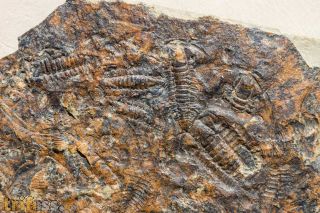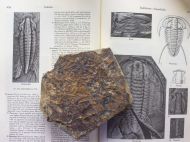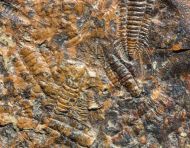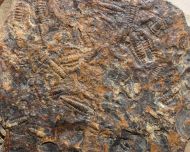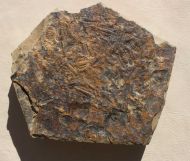Fossils for sale
Welcome back!
Sold:
Perrector (Richterops) falloti (Hupé, 1953)
Products description
| Here is a multiple plate with numerous Trilobites of the species Perrector (Richterops) falloti. This trilobite species is often also labeld as Resserops falloti. However this species hat the 11th bodysegment developpt as macrospinose pleura. On the genus Resserops ist he 9th thorax segment as a macro pleura. Additionally the two taxa differ by the total number of body segments. Richterops has typically 14 body segments and for Reserops are 12 segments assumed. Systematicly has this species a complex and changefully history. The Internet Cataloge of the Muséum national d'Histoire naturelle, Paris displays the Holotype of the speices (MNHN.F.R50854) as Resserops (Richterops) falloti HUPÉ, 1953. That is why we find this trilobite so often labels as Resserops. Resserops was along with Perrector errectet by E. & R. Richter in 1940. Henningsmoen, 1951 saw Resserops together with Eops as a synonym of Perrector. Finaly the genus Richterops was erected by Hupé, 1953 as a subgenus of Perrector with P.(R.) falloti as type species. Harrington et al. In Moore, 1959 do not mention Perrector and treat Richterops as subgenus of Resserops. Geyer 1994 still follow that concept. Chang, W.T., Repina, L.N. & Geyer, G., 1997 in Kaesler list Richterops and Resserops as subgenus of Perrector again. Jell und Adrain 2002 treat all three genera as valid taxa. In 2004 is by Geyer and Landing zhe higher systematic status of a „Resserops goup or clade” discussed. And its relation to the Metadoxididae and Resseropinae. Mainly the Paper works on the younger genus Myopsolenites ÖPIK, 1975. Dirs Álvarez et al, 2007 discuss the relationship of all thee genera together with Onaraspis in perspective to the subfamaly Resseropinae, sensu Chang, 1966. (or Zhang, 1966). Also in Elicki & Geyer 2013 is this genus addressed as Perrector (Richterops). Lots of paper has been printed since 1953 to close that circle, for now. How ever this is a nice and rich trilobite plate from the lower Cambrian of Morocco. The largest Richterops falloti on this plate is about 25 mm long. | |||
Location: | Tarzamout south of Tarroudant, Morocco | ||
| Size plate : | about 125 x 110 mm | ||
| Age: | Lower Cambrian, Issendalen Stage, Daguinaspis zone (about 530 mill. y.o.) | ||
Richter, E & R (1940): Die Saukianda-Stufe von Andalusien, eine fremde Fauna in europäischen Ober-Kambrium. Abhandlungen der senckenbergische Naturforschenden Gessellschaft 450, 1-88.
Hupé, P. (1952): Sur les zones de Trilobites du Cambrien inférieur Marocain. - C. R. Acad. Sci. Paris, 235: 480-481; Paris.
Harrington (H.J.) et al., 1959 - Arthropoda 1: Proarthopoda and Trilobitomorpha in MOORE (ed) Treatise on Invertebrate Paleontology. Part. O. Geological Society of America and University of Kansas Press, Lawrence, Kansas, p. O1-O560
ZHANG[CHANG] WENTANG (1966): [On the classification of Redlichiacea, with description of new families and new genera]. Acta Palaeontologica Sinica, 14, 135-184. [In Chinese and English]
Öpik (1975) : Cymbric Vale Fauna of New South Wales and Early Cambrian biostratigraphy. Bureau of Mineral Resources of Australia, Bulletin, 159, pp. I-IV, 1-78.
GEYER, G. (1996). The Moroccan fallotaspidid trilobites revisited. - Beringeria 18: 89-199, 69 figs .. 7 tabs.; Würzburg.
GEYER, G. & LANDING, E. (2004):. A unified Lower – Middle Cambrian chronostratigraphy for West Gondwana. Acta Geologica Polonica, 54(2), 179-218. Warszawa.
DIES ÁLVAREZ, M.E., LIÑÁN, E. & GOZALO, R. (2007):1 The Cambrian genus Onaraspis Öpik, 1968 (Trilobita), in Spain. Memoirs of the Association of Australasian Palaeontologists 34, 419-429. ISSN 0810-8889.
ELICKI , O. and GEYER, G. (2013): The Cambrian trilobites of Jordan – taxonomy, systematic and stratigraphic significance. Acta Geologica Polonica, 63 (1), 1–56. Warszawa.
Product no.: 10111
